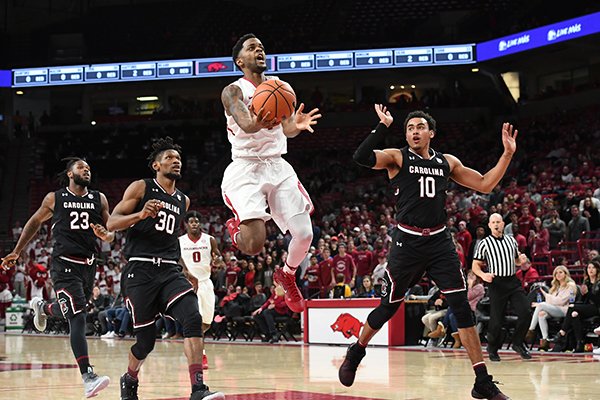LITTLE ROCK — At this moment, which is the best conference, SEC or ACC?
On one side of the argument, there is Alabama, Georgia, Auburn and LSU. On the other side, the standard bearers are Clemson, Miami, North Carolina State and Virginia Tech.
And, the winner is the SEC.
Wrong sport.
We’re talking basketball, not football — Auburn, Tennessee, Florida, Alabama and maybe Texas A&M vs. Virginia, Clemson, Duke, Miami and maybe North Carolina.
Getting accustomed to the SEC’s overnight rise to prominence in the world of college basketball takes a while. It also requires revision of the position that any SEC team would have to do 10-8 or better in the league to be assured of a bid to the NCAA Tournament.
Unthinkable for a league that has never had more than six teams in the tournament, 9-9 is in play.
Just this week, supposed experts at projecting the NCAA brackets — Joe Lunardi at ESPN and Jerry Palm at CBS — stuck by their opinions that eight SEC teams would make the tournament even though only seven teams were .500 or better in league play with eight games remaining. If they are correct, at least one of the six teams that started the week two games under .500 will make the tournament. Arkansas, which was 4-6 before its win over South Carolina on Tuesday, is in that cluttered bunch.
Looking back only one year confirms that conferences held in high esteem qualify teams that did not break .500 in conference play. The latest examples were the Big East’s Xavier and the ACC’s Wake Forest, both 9-9 in league competition last season.
The ACC led the way last year with nine teams receiving NCAA bids, including two with 10-8 records and two more at 11-7. Syracuse was also 10-8, but was left out, mostly because of a 2-11 record away from the Carrier Dome. Seven Big East teams received bids.
Pondering Arkansas’ chances of earning a bid, be sure to factor an NCAA decision last July to alter the “definition of a quality win,” placing more emphasis on winning road games by changing the team sheets handed to committee members who decide which teams get at-large bids to the tournament.
For several years, the first column of the sheets listed results against the top 50 teams in the NCAA’s Rating Percentage Index.
This year, the first column consists of home games vs. teams ranked 1-30, neutral-site games against teams in the top 50, and road games vs. opponents in the top 75.
Instead of results vs. teams ranked 51-100, the second column will include home games against teams ranked 31-75, neutral-site games vs. teams ranked 51-100 and road games against teams ranked 76-135.
A similar progression continues for two more columns.
“The emphasis of performing well on the road is important, as was the need for teams not to be penalized as much for road losses,” said Mark Hollis, committee chairman at the time. “Beating elite competition, regardless of the game location will still be rewarded, but the committee wanted the team sheets to reflect that a road game against a team ranked 60th is mathematically more difficult and of higher quality than a home game against a team ranked 35th.”
David Worlock, NCAA director of media coordination and statistics, called the visual nature of the team sheets “powerful and influential.”
As Arkansas fans know all too well, the Razorbacks are 1-6 on the road, including 1-5 in the SEC, with games remaining at Ole Miss, Alabama and Missouri.
Meanwhile, an apology is owed to Lunardi and Palm for ridiculing their decision to keep Texas A&M in the bracket projections when the then-shorthanded Aggies were 0-5 in SEC play.
After Wednesday night’s 81-80 victory that ended Auburn’s home winning streak at 13, the Aggies are 5-6 and looking more and more like one of the league’s best.

